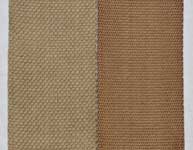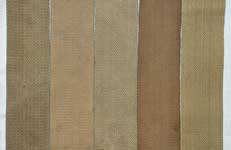| Karkee Web Home Page | Officer's Main Page | W.E.O. Main Page | W.E.O. Experimental Main Page |
Web Equipment, Officers, Experimental
Components & Data

 Ninety plus years after the Great War, judging web colour shades is an questionable prospect at best. It does appear, though, that for W.E.O., Exp., a colour shade may have been employed that was darker than that normally seen for W.E. Patt. '08. This can hardly have helped officers blend in with their men which, after all, was the point of this design. More importantly, and much more definitely, the weave pattern was entirely different. This employs doubled warp threads – the lengthways threads on the loom - with singled weft threads. The officers’ version has only single warp threads, resulting in a much finer weave, more reminiscent of a twilled weave, though not as marked an effect as with cavalry twill cloth. In the photograph at far left, the LH webbing is standard Patt. ’08 of 1915, whilst the RH webbing is 1917 dated W.E.O.. In the second photo, near left, Paul has photographed the Brace from his 1917 dated W.E.O. set with Patt. '08 from several years - left to right they are 1908, 1910, 1915, 1917 W.E.O., and 1918. The metal fittings are unusual too, Mills normally using blanked sheet brass, with the edges fettled in a rumbling machine. Those of W.E.O. have heavily radiussed edges, implying a lengthier rumbling operation than for normal fittings. This additional working provides a more polished appearance, but it has a functional purpose as well. With only a single warp thread, the officers' webbing is thinner and more prone to wear, and additional polishing on the fittings would lengthen its service life. From the Paul Hannon Collection, all photographs © Paul Hannon 2010.
Ninety plus years after the Great War, judging web colour shades is an questionable prospect at best. It does appear, though, that for W.E.O., Exp., a colour shade may have been employed that was darker than that normally seen for W.E. Patt. '08. This can hardly have helped officers blend in with their men which, after all, was the point of this design. More importantly, and much more definitely, the weave pattern was entirely different. This employs doubled warp threads – the lengthways threads on the loom - with singled weft threads. The officers’ version has only single warp threads, resulting in a much finer weave, more reminiscent of a twilled weave, though not as marked an effect as with cavalry twill cloth. In the photograph at far left, the LH webbing is standard Patt. ’08 of 1915, whilst the RH webbing is 1917 dated W.E.O.. In the second photo, near left, Paul has photographed the Brace from his 1917 dated W.E.O. set with Patt. '08 from several years - left to right they are 1908, 1910, 1915, 1917 W.E.O., and 1918. The metal fittings are unusual too, Mills normally using blanked sheet brass, with the edges fettled in a rumbling machine. Those of W.E.O. have heavily radiussed edges, implying a lengthier rumbling operation than for normal fittings. This additional working provides a more polished appearance, but it has a functional purpose as well. With only a single warp thread, the officers' webbing is thinner and more prone to wear, and additional polishing on the fittings would lengthen its service life. From the Paul Hannon Collection, all photographs © Paul Hannon 2010.